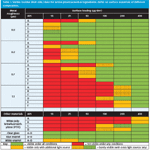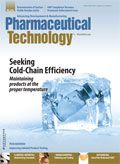Determination of Surface Visible Residue Limits on Pharmaceutical Plant Equipment
The minimum amount of residue that can be visually detected is demonstrated for a small number of active pharmaceutical ingredients (APIs) on a range of different surface materials.
Visible inspection is an essential component of a cleaning validation program and a requirement for compliance with good manufacturing practice (GMP). The use of inspection as the sole means of determining equipment cleanliness for pharmaceutical facilities was initially proposed by Mendenhall and Leblanc (1, 2). FDA's 1993 Guide to Inspection of Validation of Cleaning Processes, however, indicated that its use should be limited to batches of the same product, which has led to its limited exploitation to date within the industry (3). Nevertheless, this topic continues to be a subject of discussion; for example, a risk-based approach supported by visible residue limit (VRL) data has been proposed for R&D pilot plants, in conjunction with validated cleaning procedures (4–9).
Potential benefits of the use of visual inspection alone include significant time savings compared with the commonly used techniques of swab or rinse analysis, as well as the fact that visual inspection, in principle, has the capability of testing 100% of the equipment surface. The risks associated with factors that have been demonstrated to affect VRL measurements, however, need to be managed. These factors include observer subjectivity, lighting level, distance, viewing angle, and inspection methodology (4, 6, 8, 9).
Data published previously on VRLs have largely focused on evaluating limits on stainless-steel metal plates. For this study, using a small number of active pharmaceutical ingredients (APIs), a range of plates was assessed of different surface types typically found in API and drug-product manufacturing plants. In addition, the potential for variance in the VRL with metal-surface roughness was investigated.
Method
Surfaces examined comprised borosilicate clear glass (QVF), white polytetrafluoroethylene (PTFE), Pfaudler World Wide Glass white (9125) and dark blue (9115) Glasteel, and stainless steel S316. Metal plates of different surface roughness were examined, with the range selected to encompass actual measured values for items of equipment in the manufacturing facilities, typically between 0.0 to 0.7 µm. Additionally, a 1.1-µm surface roughness was examined to determine the consequence of any deterioration in condition of the metal. The surface roughness was measured using a Surtronic Duo instrument (Taylor Hobson), and the variation in roughness across the plates was within 10% of the stated mean.
The method was designed to minimize variables of subjectivity, environment, and solvent effects, in accordance with the conclusions reported in previous studies. The VRL evaluations were conducted under the controlled conditions of an analytical-science laboratory, determined as representative of a typical manufacturing room, with ambient lighting of approximately 300 lux. Solutions of APIs to be tested were prepared by dissolution in methanol, which was selected because the solvent leaves no surface residue and dries to a more even coverage, with minimal sample rings. APIs known to be stable to aerial oxidation were selected.
The solutions were applied dropwise to 10 x 10 cm flat plates of the various materials of construction, with concentrations set to ensure complete, even coverage of plates. A starting coverage of 10 µg/dm2 was used because it met the minimum requirements to enable useful application in actual plant equipment. Each plate was left to dry naturally before visual examination. If the API was not visible, the loading operation was repeated to increase the amount of material on the surface in a stepwise fashion until it could be visually detected on the plate. Four observers, trained as cleaning inspectors, viewed each plate independently, from a distance of between 6 and 50 inches before comparing findings. The observations were all conducted in the same location in the laboratory to minimize any variability due to lighting conditions as well as to ensure that every possible viewing angle was assessed. Each examination was conducted first in ambient laboratory lighting, followed with additional aid of a portable spotlight source. The angle and distance of the spotlight and observer were varied each time to maximize the capability to view any contamination, taking into consideration surface reflectivity. The clear glass plates were viewed from both upper and lower sides (i.e., looking directly onto and through the glass) by means of one, independent person manipulating the plate with a second person performing the role of inspector.
Results and discussion
Results from the inspections of the plates are summarized in Table I. The observations were generally consistent between the various observers, with all observers in each case reporting the same conclusion. The residue was considered to be above the VRL only if all observers could detect a residue. In the few instances where a residue was noted by some, but not all of the observers, the results were indicated as "barely detectable." Where none of the observers could detect a residue, the result was recorded as "not detected."

Table I: Visible residue limit (VRL) data for active pharmaceutical ingredients (APIs) on surface materials of different composition.
Regarding visualization of contamination, three of the APIs dried on the metal to leave a residue in the form of an approximately even, reddish-brown tarnish. All of the other materials on all surfaces dried to a residue that had the appearance of an evident white powder. This type of coverage was generally not uniformly distributed on the surface and instead appeared as many dried droplets or larger areas. This type of coverage was, however, shown in a separate activity involving deliberate soiling of an actual plant equipment as to how the contamination was deposited in the plant. Accordingly, the plate studies were considered representative for an assessment of VRLs in the processing equipment.
The following results were recorded regarding the VRLs:
- Observations for clear glass, also blue and white enamel, were consistent across all of the different compounds tested in this study. VRLs for these materials of construction were lowest for blue enamel and clear glass, viewed from either side of the glass, with all test compounds visible at 10 µg/dm2 . Two of the APIs were tested at lower loadings on these surfaces and were visible at 5 µg/dm2 and also at 2 µg/dm2 with the aid of an additional light source. The absolute VRL thresholds were not determined on these surfaces for any of these materials because they were out of the scope of this study.
- White PTFE exhibited comparatively the highest VRL, with some materials only being detected at 400 µg/dm2 with the aid of additional light source. On this surface, there was significant variance between materials.
- On metal, there was variability between VRLs across the range of the test compounds. There was also a clear correlation between metal-surface roughness and the VRL. Although there were differences in the absolute VRLs for each material, the VRLs for all test compounds increased with increasing surface roughness. Five of the six APIs were visible on the highly polished surface of 0.0 µm roughness, at 10 µg/dm2 , whereas only one was visible at 100 µg/dm2 on 1.1-µm surface roughness. There was also some variation in the rate of increase in difficulty in visualizing each compound with increasing surface roughness.
- The contamination was invariably easier to see with the additional portable light source and more obvious when viewed from an angle of approximately 30–60°. In agreement with previous studies, viewing from directly above the surface was not optimal due to surface reflections.
Conclusion
In addition to the various factors previously shown to affect VRL (such as viewing angle, distance, and lighting conditions), the new data in this study indicate that there is also a large variation in the VRL across different surface types, both in terms of materials for construction and, in the case of metal surfaces, the roughness. The data also provide supplementary evidence that the VRL varies with individual compounds, thereby further adding to the repository of knowledge concerning the effectiveness of the visual-inspection process during cleaning as well as helping to define the scope of applicability. If visual examination is to be used as the sole criterion for ensuring equipment cleanliness, a wide range of factors need to be considered. For example, where equipment is constructed from more than one material type, the absolute surface areas for each type of material should be taken into consideration in calculating the maximum theoretical residual contamination level.
The relationship between metal-surface roughness and VRL indicates the importance of knowing the roughness for each equipment item in order to determine the maximum potential contamination level accurately. Accordingly, any procedural use of "visibly clean" as a pass criterion should be supported by periodic checks of the surface roughness to ensure that the basis for acceptance is not compromised. Metal-surface roughness is a factor to be considered for any user requirement specification when ordering new equipment.
In view of the variability in VRLs on some surfaces between different compounds, in a multiproduct plant, it is necessary to conduct a test on each new material to determine the individual VRL. This test is particularly important as currently there is no evident predictor of VRL from any physical or chemical property of the subject material. The test is straightforward and significantly more rapid to perform than development of a swab or rinse method.
The above data offer definite potential for improving the efficiency and accuracy of the cleaning process by using VRLs alone. The limitations should, however, be recognized and the risk assessed on a case-by-case basis (i.e., the applicability under potentially different lighting and access conditions in the plants should be risk-assessed). Even if visual inspection, supported by the above data, is not directly used as a basis for total plant-cleaning verification, it may prove useful for individual items of equipment, or as an aid to deviation investigations.
References
1. D.W Mendenhall, Drug Develop. Indust. Pharm. 15 (13), 2105–2114 (1989).
2. D.A Leblanc, J.Pharm. Sci. Technol. 56 (1), 31–36 (2002).
3. FDA, Guide to Inspection of Cleaning processes, Division of Field Investigations, Office of Regional Operations, Office of Regulatory Affairs, (Rockville, MD, July 2004).
4. R.J Forsyth, V. Van Nostrand, and G.P Martin, Pharm. Technol. 28 (10), 58–72 (2004).
5. R.J Forsyth and V. Van Nostrand, Pharm. Technol. 29 (4), 134–140 (2005).
6. R.J Forsyth and V. Van Nostrand, Pharm. Technol. 29 (10), 152–161 (2005).
7. R.J Forsyth, J. Hartman, and V. Van Nostrand, Pharm. Technol. 30 (10), 104–114 (2006).
8. G.L Fourman and M.V.Mullen, Pharm. Technol. 17 (4), 54–60 (1993).
9. R.J. Forsyth, Pharm. Technol. 35 (3), 122–128 (2011).
David Ian Fletcher, PhD, is lead quality advisor/Lean Sigma Black Belt at AstraZeneca Pharmaceutical Development, Silk Road Business Park, Macclesfield, Cheshire, SK10 2NA, UK. David.Fletcher@astrazeneca.com.

Drug Solutions Podcast: A Closer Look at mRNA in Oncology and Vaccines
April 30th 2024In this episode fo the Drug Solutions Podcast, etherna’s vice-president of Technology and Innovation, Stefaan De Koker, discusses the merits and challenges of using mRNA as the foundation for therapeutics in oncology as well as for vaccines.
INTERPHEX 2025: Use of Walk-In Chambers for Bio/Pharma Development and Manufacturing
April 2nd 2025Sitting down with the PharmTech Group at INTERPHEX 2025, Christopher Murphy, director of Global Business Development and Service Customer Support at Environmental Specialties, discusses the design and critical role of walk-in chambers in the bio/pharmaceutical industry.


























